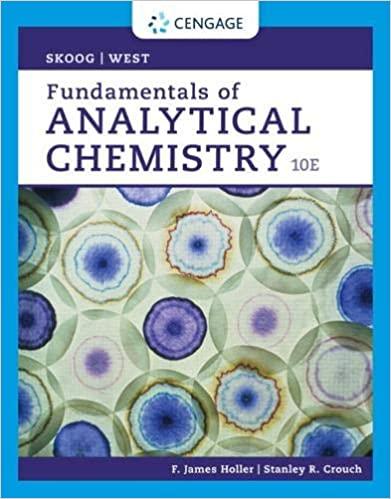Question
Please provide the required data and show calculations. Thank you. TRANSFERENCE NUMBER Objectives To determine the transport numbers of hydrogen and nitrate ions To relate
Please provide the required data and show calculations. Thank you. TRANSFERENCE NUMBER
Objectives
- To determine the transport numbers of hydrogen and nitrate ions
- To relate the transport number with ionic size and mobility
Apparatus
Phywe Transference Number Apparatus, Analytical Balance, buret, beaker, stopwatch, pipet
Reagents
Methyl red, 0.1M Nitric acid, 0.5M Copper sulfate-sulfuric acid mixture, 0.1M Sodium hydroxide, Acetone, Distilled water
Procedure
Immerse the transference vessel (double U-tube with frits and cock, GL25) up to approximately 2 cm below the lateral connecting tubes in the water-filled beaker, which serves as a temperature controlling bath (measure the temperature during the reaction); fix the U-tube to the support rod; fill it with 0.1 molar HNO3 up to external water level. After hanging the carbon electrodes in position, adjust the electrolyte level in the three legs of the U-tube to the same level, and mark this with a waterproof laboratory pencil. Subsequently, lower the transference vessel until the markings are submerged in the bath fluid to ensure sufficient temperature control. Weigh the cathode and the anode of the coulometer, which consists of two pieces of copper onto the electrode holder with the knurled screws and immersed them into a 250 ml beaker filled with a H2SO4 / 0.5 molar CuSO4 solutions. Connect this coulometer, the transference vessel and the multirange meter in series; connect them to the universal power supply with the connection cables. After the electric set up, perform the electrolysis for 60 to 90 minutes at approximately 50 mA. While doing so, ensure that the current intensity is nearly constant. Measure the exact duration of the electrolysis procedure with the stopwatch.
During this time, check the initial concentration of the nitric acid used by titrating 5 ml samples taken from the volumetric flask with 0.1 molar NaOH using methyl red as an indicator (color change: red-yellow).
At the end of the electrolysis period, take 5 ml samples in the anode and cathode regions of the transference vessel while the electric field is still being applied as quickly as possible and titrate them later to determine the concentration. Immediately after this, interrupt the electric circuit and record the exact length of the electrolysis period.
Wash the copper electrodes of the coulometer carefully with water and acetone, dry them in air, and weigh them to determine the mass change. After drying the transference vessel, determine the marked volume of the cathode and anode regions by filling them with water (50 ml buret) as a final step. The fluid displacement by the immersed electrodes is to be considered while doing this.
FINAL DATA SHEET
- Weight of Copper Plates (milligrams)
|
| W1 | W2 |
| Left | 1855 | 1853 |
| Right | 1852 | 1853 |
- Temperature: ______25_____C
- Electrolysis Time : _90 minutes
- Volume NaOH used and Volume W tube (millimeter)
|
| Volume NaOH | Volume W Tube |
| Left | 4.8 | 15 |
| Right | 5.2 | 15 |
| Original | 5.5 |
|
- Transference Number
| Transference Number | |
| Hydrogen ion |
|
| Nitrate ion |
|
- Treatment of Data
- Calculate the initial number of moles of H+ (ni) from 5 ml stock solution.
- Calculate the initial number of moles of H+ (ni) for total volume of the anode compartment.
- Calculate the final number of moles of H+ (nf) for 5 ml volume of anode compartment
- Calculate the final number of moles of H+ (nf) for total volume of the anode compartment.
- Calculate moles of electron (ne) theoretically
- Calculate moles of electron experimentally
- Calculate nmig theoretically
- Calculate nmig experimentally
- Calculate transference number of H+ (t+) and NO3- (t-) experimentally and theoretically.
t+ = nmig / ne
Step by Step Solution
There are 3 Steps involved in it
Step: 1

Get Instant Access to Expert-Tailored Solutions
See step-by-step solutions with expert insights and AI powered tools for academic success
Step: 2

Step: 3

Ace Your Homework with AI
Get the answers you need in no time with our AI-driven, step-by-step assistance
Get Started


